The concept of Coily Hair Confidence extends far beyond mere aesthetic appreciation, blossoming into a profound understanding and celebration of textured hair, particularly within the rich heritage of Black and mixed-race communities. Roothea believes that embracing one’s coily strands signifies a deeply personal and culturally resonant affirmation. This stance represents an unwavering belief in the inherent beauty and strength of coily hair, a belief cultivated through knowledge, self-acceptance, and a connection to ancestral wisdom. It is a declaration of self-worth that challenges conventional beauty norms and champions the unique characteristics of hair that spirals, kinks, and coils with a vibrant life of its own.

Fundamentals
Coily Hair Confidence, at its simplest, denotes a feeling of comfort and assurance regarding one’s natural coily hair texture. For those new to the realm of textured hair care, especially within the context of Black and mixed-race hair, this initial sense of confidence often arises from discovering the unique needs of coily strands and finding gentle ways to nurture them. It is the nascent understanding that this particular hair type, often characterized by its tight, spring-like patterns and propensity for dryness, requires a distinct approach to cleansing, moisturizing, and styling.
This fundamental meaning of Coily Hair Confidence is a quiet blossoming, a gentle realization that the hair growing from one’s scalp is not something to be managed or tamed into submission, but rather a unique expression of identity to be understood and honored. It begins with the simple recognition of its natural form, without chemical alteration or excessive heat, and the willingness to learn its language. This initial stage often involves exploring basic care routines, such as the importance of hydration, the art of detangling with kindness, and the selection of products that truly serve its thirst and structure.

Understanding the Coily Blueprint
The first step in cultivating this confidence involves a basic comprehension of what coily hair truly is. It typically falls into the Type 4 category of hair classification, encompassing patterns from tightly packed S-shapes to Z-shapes that kink without a discernible curl. This structural distinction, often characterized by a smaller circumference and a higher density of strands, means that coily hair is inherently more prone to dryness and shrinkage than other hair types. A foundational definition of Coily Hair Confidence, therefore, involves accepting these intrinsic qualities as part of its natural allure, rather than perceiving them as challenges.
- Hydration Prioritization ❉ Coily hair thrives on moisture, given its cuticle structure, which tends to be more open, allowing moisture to escape readily.
- Gentle Detangling ❉ The tight coils are prone to tangling and breakage; therefore, detangling must occur with extreme care, often when wet and saturated with conditioner.
- Protective Styling Awareness ❉ Understanding that styles which tuck away the ends of the hair, like braids or twists, can safeguard delicate strands from environmental stressors.
The journey into Coily Hair Confidence for a beginner is often marked by small, yet significant, triumphs ❉ a successful wash day that leaves strands soft and defined, a new styling technique that minimizes breakage, or simply the joy of seeing one’s natural texture celebrated. This initial phase sets the stage for a deeper appreciation, moving beyond mere acceptance to a genuine affection for one’s coily heritage.
Coily Hair Confidence begins with a gentle acceptance of one’s natural texture, learning its unique language of hydration and care.
For many, this initial step represents a departure from years of conforming to Eurocentric beauty standards, a silent revolution within their personal beauty regimen. It is a moment of re-connection, a reclaiming of a natural state that may have previously been hidden or altered. This simple understanding of coily hair’s needs forms the bedrock upon which more profound layers of confidence are built.

Intermediate
Moving beyond the initial acknowledgment, the intermediate meaning of Coily Hair Confidence delves into a more active, conscious engagement with one’s textured hair. This stage involves not just understanding basic care, but applying that knowledge with increasing skill and discernment, transforming routine into ritual. Here, the individual begins to grasp the practical applications of Coily Hair Confidence, recognizing how specific products, techniques, and even lifestyle choices directly influence the health and vibrancy of their strands. This expanded awareness often manifests in a more personalized hair care regimen, tailored to the nuances of their specific coil pattern, porosity, and density.
The individual at this level understands that Coily Hair Confidence is a dynamic process, one that requires consistent observation and adaptation. They might begin to experiment with different deep conditioning treatments, explore various styling methods to achieve different looks, or become adept at deciphering ingredient lists to select formulations that truly benefit their hair. This phase marks a transition from simply following instructions to truly listening to one’s hair, interpreting its responses, and making informed decisions about its care. It is a deepening of the relationship, moving from acquaintance to a more intimate partnership.

Practical Applications and Daily Rituals
At this intermediate level, Coily Hair Confidence translates into tangible practices. Individuals begin to understand the rhythm of their hair, recognizing when it needs moisture, protein, or a clarifying cleanse. They might adopt specific regimens, such as the “LOC method” (Liquid, Oil, Cream) or “LCO method” to seal in moisture, or develop a personalized wash-day schedule that optimizes their hair’s health. The focus shifts from merely surviving wash day to creating an enjoyable and effective experience that nurtures the hair and the spirit.
| Method LOC Method |
| Order of Application Liquid, Oil, Cream |
| Purpose To provide hydration (liquid), seal with oil, and then add a cream for further moisture and styling. |
| Method LCO Method |
| Order of Application Liquid, Cream, Oil |
| Purpose To provide hydration (liquid), seal with cream, and then add oil for additional sealing and shine. |
| Method These methods are adaptable to individual hair needs and product preferences. |
The daily or weekly hair care ritual becomes a testament to this growing confidence. It is a time of mindful engagement, where each step, from pre-pooing to styling, is performed with intention and a growing sense of mastery. This deeper engagement often brings about noticeable improvements in hair health, leading to less breakage, more definition, and a more vibrant appearance, further reinforcing the individual’s confidence in their hair and their ability to care for it.
Beyond the physical care, the intermediate stage of Coily Hair Confidence also encompasses a greater comfort in styling and presenting one’s natural texture in various settings. This might involve confidently wearing a wash-and-go style, experimenting with different braid or twist-out techniques, or simply allowing one’s hair to defy gravity in an Afro. The hesitation that might have been present in the fundamental stage begins to recede, replaced by a quiet assertion of self.
Cultivating Coily Hair Confidence at an intermediate level involves a conscious engagement with textured hair, transforming routine care into a personalized ritual of profound nourishment.
This deeper understanding also extends to appreciating the versatility of coily hair, recognizing that its structure allows for a multitude of expressions. It is a quiet rebellion against the singular beauty standards that have historically dominated, a celebration of the myriad ways coily hair can be styled and adorned while maintaining its health and integrity.

Advanced
The advanced level of Coily Hair Confidence transcends personal practice, elevating to a profound, scholarly interpretation rooted in biological, historical, psychological, and social factors. This is not merely about styling one’s hair, but understanding the very fabric of its existence within a global narrative, particularly for individuals of Black and mixed-race heritage. At this stratum, Coily Hair Confidence signifies a comprehensive intellectual and emotional grasp of the unique molecular structure of coily hair, its genetic predispositions, and the intricate ways it interacts with its environment, alongside a critical awareness of the socio-historical pressures that have shaped its perception.
This sophisticated explication of Coily Hair Confidence acknowledges that the journey of textured hair is inextricably linked to the broader experiences of identity, systemic bias, and cultural reclamation. It delves into the scientific specifics of the hair follicle’s elliptical shape, which contributes to the tight curl pattern, and the distribution of disulfide bonds that grant it resilience yet also vulnerability to breakage. Simultaneously, it scrutinizes the enduring impact of historical subjugation and Eurocentric beauty ideals that have long sought to diminish the intrinsic beauty and professionalism associated with coily textures. This nuanced understanding empowers individuals not only to care for their hair with unparalleled precision but also to advocate for its rightful place in all societal spheres.

The Interplay of Science, Society, and Self-Worth
An advanced understanding of Coily Hair Confidence necessitates a deep dive into the scientific underpinnings of textured hair. Coily hair, often categorized as Type 4, exhibits a distinct helical structure, a result of the elliptical cross-section of its follicle and the uneven distribution of keratin along the hair shaft. This structural particularity, while contributing to its remarkable volume and unique aesthetic, also renders it more susceptible to dryness and mechanical damage due to fewer cuticle layers and a greater number of twists and turns. The meaning here extends to appreciating these biological truths as intrinsic aspects of its identity, rather than flaws to be corrected.
Furthermore, this advanced perspective scrutinizes the historical and psychological dimensions of Coily Hair Confidence. For centuries, individuals with coily hair, particularly Black women, have faced immense pressure to alter their natural texture to conform to prevailing beauty standards, often at significant physical and emotional cost. The pervasive societal perception of coily hair as “unprofessional” or “unkempt” has led to tangible discriminatory outcomes in educational and professional settings. For instance, a 2023 CROWN Workplace Research Study revealed a striking reality ❉ Black Women’s Hair is 2.5 Times More Likely to Be Perceived as Unprofessional Than Other Hair Types.
This perception leads to quantifiable disadvantages, with approximately two-thirds (66%) of Black women reporting they change their hair for a job interview, and 41% of those changing it from curly to straight. This deeply embedded bias is not merely aesthetic; it impacts career trajectories, economic mobility, and psychological well-being, manifesting as microaggressions and overt discrimination.
This context illuminates why Coily Hair Confidence is not a superficial concept but a profound act of self-affirmation and resistance. It requires confronting internalized biases and external pressures, a deliberate choice to honor one’s authentic self. The significance of this confidence is therefore intertwined with a legacy of resilience, a quiet yet powerful declaration of cultural pride that pushes back against systemic inequities.

Deconstructing Societal Perceptions
The societal denigration of coily hair is a complex phenomenon, often rooted in historical power dynamics and the perpetuation of Eurocentric beauty ideals. This has led to what some scholars term “hair bias” or “curlism,” where tighter curl patterns face disproportionate scrutiny and negative judgment. The advanced meaning of Coily Hair Confidence thus involves recognizing these systemic biases and actively working to dismantle them, both individually and collectively.
- Implicit Bias Recognition ❉ Understanding that many individuals, regardless of their own background, may hold unconscious biases against textured hair, rating it as less beautiful or professional.
- Economic Implications ❉ Acknowledging how hair discrimination can lead to limited job opportunities, reduced career advancement, and even disciplinary actions, impacting financial stability.
- Psychological Burden ❉ Recognizing the mental health toll, including anxiety, stress, and diminished self-esteem, that arises from constant pressure to conform or navigate microaggressions.
The advancement of Coily Hair Confidence on this plane means engaging with research, supporting legislative efforts like the CROWN Act, and fostering environments where all hair textures are celebrated without prejudice. It is an informed, deliberate choice to embody a beauty standard that is expansive and inclusive, challenging the very foundations of discriminatory norms. This intellectual and emotional investment transforms personal confidence into a powerful catalyst for broader social change, affirming that one’s hair is not merely a style, but a symbol of identity, heritage, and unwavering self-respect.
The expert-level comprehension of Coily Hair Confidence extends to recognizing its role in fostering collective identity and cultural preservation. For Black and mixed-race communities, hair has historically served as a potent symbol of social status, tribal affiliation, and spiritual connection. The act of wearing coily hair naturally, without alteration, becomes a conscious link to this rich ancestry, a visual affirmation of heritage that transcends superficial trends. This deep connection to cultural roots provides a robust framework for personal confidence, grounding it in something far greater than individual preference.
| Era/Concept Slavery & Post-Emancipation |
| Impact on Coily Hair Forced alteration, covering of hair, denigration of natural textures as "unruly." |
| Relevance to Confidence Confidence becomes an act of resistance, reclaiming autonomy over one's body and identity. |
| Era/Concept "Good Hair" vs. "Bad Hair" |
| Impact on Coily Hair Internalized racism, preference for straighter textures, self-hatred. |
| Relevance to Confidence Confidence means deconstructing these harmful narratives and celebrating intrinsic beauty. |
| Era/Concept Black Power Movement (1960s-70s) |
| Impact on Coily Hair Resurgence of Afros and natural styles as symbols of pride and political statement. |
| Relevance to Confidence Confidence is a political statement, a celebration of self-love and cultural heritage. |
| Era/Concept Modern Natural Hair Movement |
| Impact on Coily Hair Increased acceptance, product innovation, but persistent discrimination. |
| Relevance to Confidence Confidence involves navigating a complex landscape, advocating for wider acceptance and policy change. |
| Era/Concept Understanding this historical trajectory provides a deeper appreciation for the resilience inherent in Coily Hair Confidence. |
This advanced perspective also critically examines the role of industry and media in shaping perceptions. While the natural hair movement has spurred growth in dedicated product lines and increased visibility, it also highlights the persistent challenges. The ethical implications of beauty standards, the nuances of marketing, and the responsibility of content creators all fall within this advanced purview. A truly confident individual at this level not only consumes but also critically evaluates, contributing to a more equitable and celebratory ecosystem for textured hair.
The pinnacle of Coily Hair Confidence involves a comprehensive understanding of its scientific intricacies, its historical subjugation, and its profound role as a symbol of identity and resistance.
Ultimately, this advanced definition of Coily Hair Confidence is a call to action, a recognition that personal self-acceptance is intrinsically linked to collective liberation. It demands a sophisticated awareness of the forces that have shaped, and continue to shape, the textured hair experience, enabling individuals to stand firm in their truth and inspire others to do the same. This level of confidence is a wellspring of empowerment, transforming personal choice into a powerful cultural statement.

Reflection
Coily Hair Confidence, as we have explored, is a dynamic and deeply personal journey, yet one that echoes through generations and across communities. It is a quiet revolution unfolding on individual scalps and within collective consciousness, moving from tentative steps of acceptance to profound declarations of identity. Each coil, each kink, each tightly wound strand holds not only its unique biological story but also the weight of history, the resilience of heritage, and the promise of a future where natural beauty is universally honored.
This confidence is a testament to the strength found in authenticity, a gentle yet unyielding assertion that one’s inherent self is more than enough. It calls upon us to look beyond superficial standards, to truly see and celebrate the intricate wonders that nature bestows. In a world that often seeks conformity, the decision to wear coily hair with confidence is a radical act of self-love, a vibrant affirmation that reverberates far beyond the mirror, inspiring a broader acceptance and appreciation for the diverse spectrum of human beauty.
The journey of Coily Hair Confidence, therefore, is never truly complete; it is an ongoing dance of discovery, care, and advocacy. It invites us to remain curious, to continue learning, and to stand in solidarity with all who seek to define beauty on their own terms. May we all find such profound assurance in our own unique expressions, allowing our authentic selves to shine with an undeniable, radiant glow.

References
- Byrd, A. D. & Tharps, L. (2014). Hair Story ❉ Untangling the Roots of Black Hair in America. St. Martin’s Griffin.
- Ellis-Hervey, N. L. Doss, A. C. Davis, D. Nicks, N. & Araiza, D. (2016). African American Women’s Perceptions of Self-Value in the Transition to Natural Hair. Journal of Black Psychology, 42(4), 365-387.
- Johnson, J. M. & Bankhead, T. (2014). Hair It Is ❉ The Psychological Meaning of Hair for African American Women. Journal of Black Psychology, 40(4), 379-399.
- Maddox, K. B. (2014). The Social Psychology of Hair ❉ A Review of the Literature. Journal of Social Psychology, 154(3), 211-224.
- Opie, T. & Phillips, R. (2015). The Hair-raising Truth ❉ The Psychological Impact of Hair Discrimination on Black Women. Psychology of Women Quarterly, 39(4), 499-513.
- Perception Institute. (2016). The Good Hair Study. New York, NY ❉ Perception Institute.
- Rosette, A. S. & Livingston, R. W. (2020). The Professionalism of Black Women’s Hair ❉ Bias and the Impact on Job Opportunities. Social Psychological and Personality Science, 11(7), 967-975.
- Thompson, C. (2009). Black Women and Identity ❉ A Psychological Exploration of Hair. Journal of Black Studies, 39(5), 785-801.
- The CROWN Act. (2023). 2023 CROWN Workplace Research Study. Retrieved from The Official CROWN Act website.
- Dove. (2021). 2021 CROWN Research Study for Girls. Retrieved from The Official CROWN Act website.
- Brookings Institution. (2021). Penalizing Black hair in the name of academic success is undeniably racist, unfounded, and against the law. Retrieved from Brookings.edu.